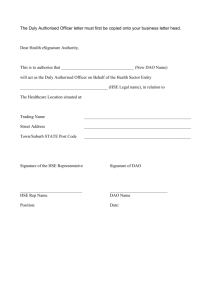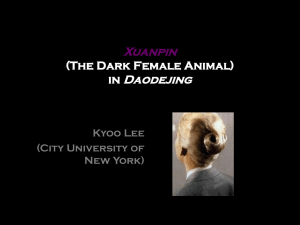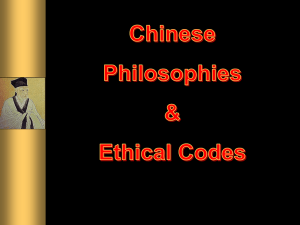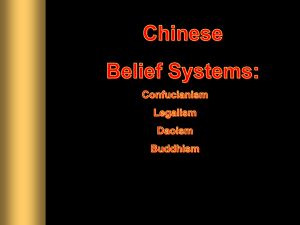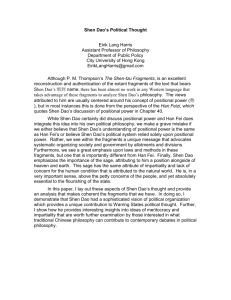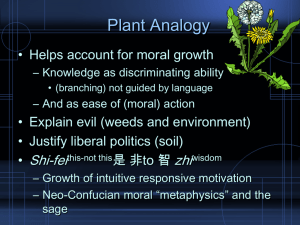Reconstruction of Philosophy of Dao - UK
advertisement
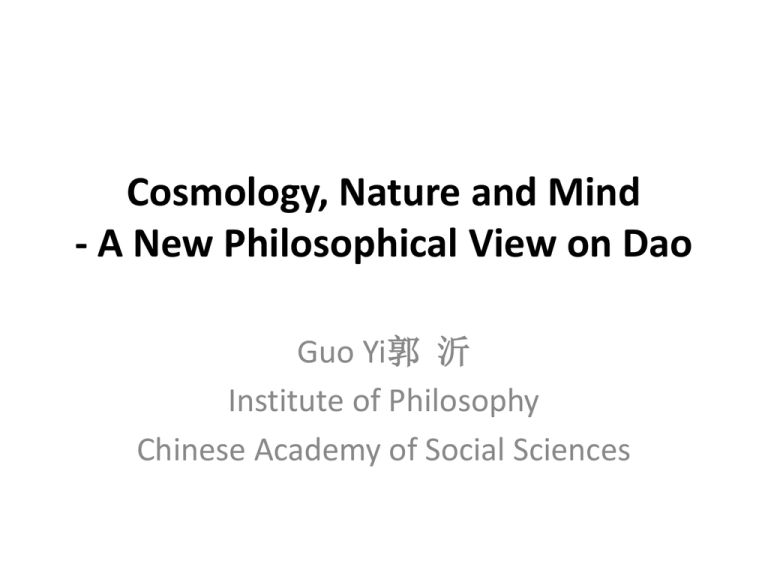
Cosmology, Nature and Mind - A New Philosophical View on Dao Guo Yi郭 沂 Institute of Philosophy Chinese Academy of Social Sciences Introduction • 1. The crisis of humanity and Philosophy • Since the 19th century, both Chinese and Western philosophies have suffered under the impact of modernization and capitalism. • Since its beginning, Chinese philosophy has focused on the value and meaning of life. • Virtue and the knowledge of virtue were addressed as “honoring virtue”(zun de xing尊 德性) and “following the path of study and inquiry”(dao wen xue道问学) separately by ancient Chinese philosophers. • In Western culture, the original meaning of Philosophy is “love of wisdom”. This confirms that since the very beginning, Western Philosophy was interested in knowledge. • Despite this, the key issues in traditional Western Philosophy before Kant and traditional Chinese Philosophy are very similar. • But since modern times, Western philosophers have been chiefly concerned with the world of knowledge and have taken knowledge as their highest goal. • Bacon: “knowledge is power” • The knowledge in question is natural knowledge; the rationality they revered is instrumental rationality. • Meanwhile value left quietly • modernization has brought to our time not only dramatic changes and previously unknown material pleasures, but also the pollution of the environment, the clash of civilizations and the decline of value. • At the same time, modern Philosophy, infiltrated by modernity, has lost its way. • Kant: ”man and generally any rational being exists as an end in himself” • Therefore, in any reasonable philosophical system, a theory of value should occupy the dominant and central position, and a theory of knowledge a subordinate position. • The crisis of humanity and Philosophy is the crisis of value. • 2. The defects and tasks of Chinese and Western philosophies • The major defect of Chinese Philosophy is the absence of a theory of knowledge, while the major defect of Western Philosophy is the breakdown of its theory of value. • Therefore the challenge for Chinese Philosophy is to construct a theory of knowledge to support its theory of value. The challenge for Western Philosophy is to reconstruct its theory of value to govern its theory of knowledge. • 3. How to establish the new philosophical system that places its theory of value in the lead role, its theory of knowledge in a supporting role. • We should adopt a correct attitude forward Metaphysics. • Metaphysics is the lifeblood of Philosophy. • Since Aristotle, Metaphysics has been called the first Philosophy. • Modern Western Philosophy began to turn away from Metaphysics to concrete science, from substance to phenomenon, from the a priori to experience. • The separation between substance and phenomenon is a basic characteristic and also a key limitation of traditional Western Metaphysics. It has resulted in the decline of traditional Western Metaphysics. • It requires us not to throw Metaphysics away, but to reform and even to rebuild it. • Metaphysics also is the foundation and core of Chinese Philosophy. • the traditional Chinese Metaphysics concerns itself with three levels, namely Ontology, human nature and the human mind. • The source of the term “metaphysics” (Xing er shang xue) in Chinese philosophy: • The commentaries of The Book of Changes:形而 上者之谓道, 形而下之谓器 • Wing-Tsit Chan’s translation: • What exists before physical form [and is therefore without it] is called the Way. What exists after physical form [and is therefore with it] is called a concrete thing. • My translation: what is beyond physical form is called Dao, what has physical form is called a concrete thing. • this metaphysical system has none of the aforementioned drawbacks of Western Philosophy, moreover it could rectify these drawbacks. • To develop the theories of life, ethics, society and politics by constructing or revising Metaphysics is fundamental method in Chinese Philosophy • An important characteristic of Chinese Metaphysics is the combination of cosmology and ontology. I. The Sphere of Dao - where we come from 1.1 1. The Big Bang Theory and the Philosophical Cosmology in Ancient China • (1) The Big Bang Theory • cosmogony has made marked progress and became a notable form of learning and it cannot but be a solid foundation for constructing a contemporary Metaphysics. • Big Bang Theory has been broadly accepted. • 14 billion years ago, this single point exploded and expanded rapidly and produced the universe. • When the expansion stops, as the gravity of its galaxies causes the universe collapse and condense, all galaxies will assemble closer and closer, until finally the universe becomes a single high density point. (2). The philosophical cosmologies in ancient China • Cosmology in ancient China could be divided into two branches, namely astronomical cosmology and philosophical cosmology. • No doubt the ancient philosophers could not imagine the above development of modern cosmogony, but it is striking that the cosmological models they established are very similar. • The Philosophical cosmology in ancient China could be divided into three cosmological models. • The first one holds that the universe formed from an original spot, and the myriad things were produced by the original spot. • the Lao zi on Bamboo slips appeared in the last part of the Spring and Autumn period, at the same time as [the philosopher] Lao zi, who was a contemporary of Confucius. The modern edition (including the edition written on silk) of the Lao zi comes from Taishi Dan who lived in the middle period of the Warring States and is a contemporary with Duke Xian of Qin. • there are two different persons and two different books. • Guodian • “there was a state which formed bamboo text chaotically. It existed before the sky and the earth. It is quiet, Laozi老聃: independent, and never changes “有状混成, its nature. It may be considered 先天地生, the mother of the myriad things. 寂寥,独立, No one knows its name. I call it 不改,可以 Dao. If forced to give it a name, I 为天下母。 will call it the Great. The Great 未知其名, begins to depart, and then it 字之曰道, becomes further and further away, 吾强为之名 and then returns to the original 曰大。大曰 point.” 逝,逝曰远, 远曰反。” • Guodian baboo • The Great One gave birth to text Taiyi sheng water. Water returned and assisted Taiyi, in this way shui太一生水, developing heaven. Heaven and 水反辅太一, earth [repeatedly assisted each 是以成天。天 other], in this way developing 反辅太一,是 the “gods above and below.” 以成地。天地 The “gods above and below” 〔复相辅〕也, repeatedly assisted each other, 是以成神明。 in this way developing Yin and 神明复相辅也, Yang. Yin and Yang repeatedly 是以成阴阳。 assisted each other, in this way 阴阳复相辅也, developing the four seasons. 是以成四时。 • 阴阳复相辅也, • The four seasons repeatedly assisted each other, in this way 是以成四时。 developing cold and hot. Cold 四时复〈相〉 and hot repeatedly assisted 辅也,是以成 each other, in this way 凔热。凔热复 developing moist and dry. Moist 相辅也,是以 and dry repeatedly assisted 成湿燥。湿燥 each other; they developed the 复相辅也,成 year, and the process came to 岁而止。 an end. • Therefore, the year was • 故岁者,湿燥 produced by moisture and 之所生也。湿 dryness; moisture and dryness 燥者,凔热之 were produced by cold and hot. 所生也。凔热 Cold and hot and the four 者,四时之所 seasons, were produced by Yin 生也。四时者, and Yang. Yin and Yang were 阴阳之所生 produced by the “gods above 〔也〕。阴阳 and below.” The “gods above 者,神明之所 and below” were produced by 生也。神明者, heaven and earth, and heaven 天地之所生也。 and earth were produced by the 天地者,太一 Great One. 之所生也。 • This being so, the Great One is • 是故太一藏于 concealed in water and moves with 水,行于时。 the four seasons. Completing a 周而或〔始, cycle, [it starts] over again; [we 以己为〕万物 regard] Taiyi [as] the mother of the 母;一缺一盈, ten thousand things: first it is 以己为万物经。 depleted, then it is full; we regard 此天之所不能 Taiyi as the guiding principle of the 杀,地之所不 ten thousand things. This is 能厘,阴阳之 something that heaven cannot 所不能成。 destroy, the earth cannot smother, and Yin and Yang cannot produce. The gentleman knows this is referred to as [a sage]. • 《潜夫论·本训》谈到了一种类似的宇宙模式: “上古之世,太素之时,元气窈冥,未有形 兆,万精合并,混而为一。莫制莫御,若斯 久之。翻然自化,清浊分别,变成阴阳。阴 阳有体,实生两仪。天地壹郁,万物化淳。 和气生人,以统理之。” • The second cosmological model not only holds that the universe came from an original point, but also explores the matrix that produced the original point, consequently leading us into a transcendent and absolute world. • The received version of Lao Zi 太史儋:“道生 一,一生二,二 生三,三生万物。 万物负阴而抱阳, 冲气以为和。” “Dao produced the One, the One produced the Two, the Two produced the Three, The Three produced the myriad things. The myriad things carry the yin and embrace the Yang, and through the quiet and peaceful Qi, they achieve harmony.” • The One was produced by Dao, the ultimate basis for the original point is Dao. • the Dao of Taishi Dan differs from the Dao of Lao Dan. The latter is the original point of the universe, while the former is the transcendent and absolute world of the producer of the original point. • 上海博物馆藏战国楚竹书《恒先》也讨论了 前元点状态,并且对宇宙生成过程作了更加 详细的描述:“恒先无有,朴,静,虚。朴, 太朴。静,太静。虚,太虚。自厌,不自忍, 或作。有或焉有气,有气焉有有,有有焉有 始,有始焉有往者。未有天地,未有作行, 出生虚静,为一若寂,梦梦静同,而未或明, 未或滋生。气是自生,恒莫生气。气是自生 自作。恒气之生,不独,有与也。或,恒焉。 生或者同焉。……浊气生地,清气生天,气 信神哉,云云相生。” • 成书于汉代的《易纬·乾凿度》延续了这一思 路:“有太易,有太初,有太始,有太素也。 太易者,未见气也。太初者,气之始也。太 始者,形之始也。太素者,质之始也。气形 质具而未离,故曰浑沦。浑沦者,言万物相 浑成,而未离也。视之不见,听之不闻,循 之不得,故曰易也。” • The third cosmological model comes from Confucius in his late years. • Xi Ci系辞, section of the Yi Zhuan易传 or The Commentaries on the Book of Changes: • in the sphere of Yi 易 there is • 是故易有太极, Taiji 太极(or the Great 是生两仪。两 Ultimate). It generates the Two 仪生四象。四 Forms (yin and yang). The Two 象生八卦。八 Forms generate the Four 卦定吉凶,吉 Forms (major and minor yin 凶生大业。 and yang). The Four Forms generate the Eight Trigrams. The Eight Trigrams determine good and evil fortunes. And good and evil fortunes produce the great enterprise. • The Eight Trigrams correspond to eight cosmological elements, including the sky, the earth, thunder, wind, water, fire, mountain and marsh. • Yi is the transcendent and absolute world and it corresponds to Dao of Taishi Dan. • “Taiji” corresponds “the One” in Taishi Dan’s saying “Dao produced the One” and should be the original point of the universe. • the sentence “in the sphere of Yi there is Taiji or the Great Ultimate” may have two meanings. First, Yi contains Taiji; second, Taiji and Yi exist simultaneously and they are not related in theirs of “production” or “was produced”. (3). the inner connection between the single point and the myriad things • Like the Big Bang Theory, the above philosophical cosmologies in ancient China hold that the universe comes from an original point and undergoes a process of development or expansion. • The similarities are the result of the similarity between process of generation and development of the universe and of the myriad things. • Georges Lemaître, who advocated Big Bang Theory first compared the process of the universe expanding from the “primeval atom” to the process of a big oak tree growing from a small acorn. • Modern biology proved that parents’ genes could be inherited by their children, while most members of an ethnic group carry the same gene. • Based on this, we can conclude that as the mother of the universe, the single point should contain all basic information, and all things should carry the original information of the single point. • The ancient philosophers believe that in the process of producing, the producer gave its own nature to the myriad things. • For instance, the received version of Laozi said: • When the uncarved wood is broken up, it is turned into • 天下有始,以为 concrete things. 天下母。既得其 • There was the beginning of 母,以知其子。 the myriad things. Which 既知其子,复守 may considered as the 其母,没身不殆。 mother of the myriad things. He who has found the mother, and thereby he can understand her children. • 朴散则为器。 • For Lao Zi, Dao should be divided into two kinds or levels, namely original Dao and secondary Dao. Original Dao is the Dao which has the creative power and is the broad root of all things. Secondary Dao is the Dao which is in all things or was obtained by all things. To all things, the secondary Dao is de or virtue. • 孔子说:“乾坤,其易之蕴邪?乾坤成列, 而易立乎其中矣。乾坤毁,则无以见易。易 不可见,则乾坤或几乎息矣。”又说:“天 地设位,而易行乎其中矣。成性存存,道义 之门。” • So we can also divide Confucius’ concept of Yi into original Yi and secondary Yi. Unlike Laozi, Confucius named Yi which is in Tian and Earth, the secondary Yi referring to xing or nature directly. • 宋明理学家们进一步提出了“理一分殊”的 观念,而朱子更用“月印万川”的现象作了 明白形象的阐释:“本只是一太极,而万物 各有禀受,又自各全具一太极尔。如月在天, 只一而已,及散在江湖,则随处而见,不可 谓月已分也。” • Following traditional Chinese Metaphysics, I would like to reconstruct Metaphysics into three parts or spheres, namely Dao Ti 道体 (or the sphere of Dao), Xing Ti 性体 (or the sphere of Nature) and Xing Ti 心体 (or the sphere of Mind). 2. The Composition of Dao • The sphere of Dao is a transcendent and absolute world. It is the origin of the universe, the root of the world and the mother of the myriad things. It is an absolute “great whole” 大全, boundless, ceaseless, all-embracing, without beginning or end. • the sphere of Dao is formed by three fundamental elements, namely Zhi值, Li理 and Qi气. • Zhi值is the locus of value and meaning. Qi 气is locus of energy and matter. Li 理is the locus of form, reason, law and principle. • there are two kinds of Li. One exists in Zhi and could be named as Zhi Li 值理(or the law of value). Another exists in Qi and could be named as Qi Li 气理(or the law of matter). • Zhi, Qi and Li have different properties. • Zhi is the highest element, Qi is the lowest, and Li is between them. • Dao has ten characteristics, namely Heng 恒 (or eternal), Pu 朴(or plain), Jing 静 (or quiet), Xu 虚(or vacuous), Du 独 (or independent), Cheng 诚(or facticity), He 和(or harmonious), Sheng 生(or productive), Ren 仁(or benevolent), Yi 易 (or change). The general property of them is Heng or eternal. They together are called Shi De 十德(or “the Ten Characteristics”). 3. From the Wuji or Non-ultimate to Taiji or the Great Ultimate • In the sphere of Dao, Zhi值, Li理 and Qi气 are eternal. They are the thing-in-itself. So they could be called respectively Heng Zhi恒值 (or the Eternal value), Heng Li恒理 (or the Eternal reason), and Heng Qi恒气 (or the Eternal matter-energy). • This state of Dao is Wuji无极 (or NonUltimate). • The immediate origin of the universe is Taiji or the Great Ultimate which scientists called the single point. • Dao is a mother, Taiji or the Great Ultimate is her egg, the universe is her child that came from the egg. • When the Eternal value, the Eternal reason, the Eternal matter-energy come together, they forme Taiji太极 or the Great Ultimate. This is the single point and the direct producer of the universe. • The Eternal value, the Eternal reason and the Eternal matter-energy in Taiji could be called Tai Zhi太值 or the Primeval Value, Tai Li太理 or the Primeval Reason and Tai Qi太气 or the Primeval Matter-energy respectively. • Tai Zhi and Tai Li are in Tai Qi, and not separate from Tai Qi. • Inasmuch as Tai Qi is one kind of matter-energy, so it should be a limited being, and this determines Tai Zhi and Tai Li that Tai Qi carries are also limited. 4. Taiji or the Great Ultimate Produces the Myriad Things • As for the process by which Taiji or the Great Ultimate produces the universe and the myriad things, I accept Zhou Dunyi’s (10171073) idea in his work An Explanation of the Diagram of the Great Ultimate: • 周敦颐《太极 • The Great Ultimate through movement generates yang. 图说》:无极 When its activity reaches its limit, 而太极。太极 it becomes tranquil. Through 动而生阳,动 tranquility the Great Ultimate 极而静;静而 generates yin. When tranquility 生阴,静极复 动。一动一静, reaches its limit, activity begins again. So movement and 互为其根;分 tranquility alternate and become 阴分阳,两仪 the root of each other, giving rise 立焉。 to the distinction between yin and yang, and the two modes are thus established. • By the transformation of yang • 阳变阴合而生 and its union with yin, the Five 水火木金土, Agents of Water, Fire, Wood, 五气顺布,四 Metal, and Earth arise. When 时行焉。五行 these five material forces (Qi) 一阴阳也,阴 are distributed in harmonious 阳一太极也, order, the four seasons run their 太极本无极也。 course. The Five Agents constitute one system of yin and yang, and yin and yang constitute one Great Ultimate. The Great Ultimate is fundamentally the Non-ultimate. • The Five Agents arise, each with • 五行之生也, its specific nature. When the 各一其性。无 reality of the Non-ultimate and 极之真,二五 the essence of yin, yang, and 之精,妙合而 the Five Agents come into 凝。乾道成男, mysterious union, integration 坤道成女。 ensues. Qian (Heaven) constitutes the male element, and Kun (Earth) constitutes the female element. • 二气交感,化 生万物,万物 生生而变化无 穷焉。 • The interaction of these two material forces engenders and transforms the myriad things. The myriad things produce and reproduce, resulting in an unending transformation. • Taiji or the Great Ultimate, corresponds to the single point; the Five Agents of Water, Fire, Wood, Metal, and Earth correspond to the elementary particles and various cosmological materials after the Big Bang. • The only absolutely eternal one is Dao. Taiji or the Great Ultimate has a beginning and an end. The universe that Taiji produced is also limited, and will experience a process from generation to growth to death. • When Taiji or the Great Ultimate evolved and became the universe, it existed in the universe and the myriad things. • Taiji or the Great Ultimate could be divided into two levels. One is the producer, which could be called the Original Great Ultimate, and another is the Taiji which was in the myriad things, and could be called the Secondary Great Ultimate. • when the single point evolved into the universe, or the Original Great Ultimate evolved into the Secondary Great Ultimate, Dao itself ran through the myriad things. • The Secondary Great Ultimate is Xing性 (or the Nature) of the myriad things. • As the Great Ultimate was formed by Zhi, Li and Qi, therefore Xing or Nature as the Secondary Great Ultimate also could be divided into three kinds, namely the Nature of Zhi值之 性(or the Value Nature), the Nature of Li理之 性(or the Reason Nature), and the Nature of Qi 气之性(or the Physical Nature). • As embodiment of Dao, on the one hand, Taiji is the source of the universe, so that it is transcendent and a priori. On the other hand, it runs through the myriad things, so that it is internal and experiential. As the relation between Taiji and Dao, we can say Dao is transcendent and also internal, a priori and also experiential. II. The Sphere of Xing or Nature - what we are 2.1 The Difference Between the Nature of Man and the Nature of Things • (1) physical nature • As the myriad things inherit their own Qi from Tai Qi in thousands of ways, the physical nature in the myriad things is different in thousands of ways • Xunzi (313-238 B.C.): “Water and fire have Qi but not life, plants have life but not awareness, animals have awareness but not the consciousness of Yi or justice. Man has all of Qi, life, awareness and the consciousness of justice.” • A. Thing with Qi: a mineral • B. thing with life: a plant • C. thing with awareness: an animal • D. thing with the consciousness of justice: a man • Xing or Nature is the totality of the properties a thing possesses • The property or properties that represent the essence of one kind of thing may be called its Essential Nature. • The other property or properties may be called its Non-essential Nature • Essential Nature: • A. plant: life • B. animal: animal mind • C. man: human mind • Essential Nature is the narrow meaning of Nature • human mind is human nature, mind is nature • (2) value nature • Does everything among myriad things have value nature? Is the value nature of the myriad things same? • A. Laozi, and later Confucius and Zisi all held that everything among the myriad things has a nature, but they did not specify whether the value nature of the myriad things was the same or not. • B. from Mencius’ point of view, the term “nature” is value nature, only human beings have nature in the world. • C. Zhu Xi believed that every one of the myriad things has value nature, humans have a complete value nature, but things only have a partial value nature, different things have different endowment. • D. my point of view: The difference between physical nature determines differences of value nature and reason nature, only men have value nature. • • • • (3) the Reason Nature A. the Reason Nature of Value B. the Reason Nature of Matter the difference between physical nature and value nature among the myriad things determines the difference between their reason natures. • only man as the thing with an awareness of justice has the reason nature of value. • The difference between human beings and animals does not only manifest itself as completeness or partialness and high or lowness as aforementioned, but also in facilitation or obstruction. • Facilitation and obstruction refer to the ability of self-realization. • Compared with the Original Great Ultimate, all the Secondary Great Ultimate, including that of human beings, is more partial and lower, as the qi the myriad things received is partial and lower. • Since the Original Great Ultimate received limited information from Dao, and the myriad things received limited information from the Original Great Ultimate, the Dao in the myriad things is quite limited. 2.2 Differences in Human Nature • Is the nature that each and every person received from the Great Ultimate same or different? • A. Confucius said, “By nature men are similar. Through practice they have become far apart.” • B. Mencius believed each and every person has the Four Beginnings and they are same among all persons. • He said, “Not only do virtuous men have the mind of Four Beginnings, but everybody has it.” “The sages realize what is the same in our minds before others.” • C. philosophers in the Song and Ming Dynasties hold that for every person, physical nature is different, but the nature of Heaven and Earth that corresponds to value nature is the same. • D. my point of view: Every person inherits his or her physical nature in thousands of different ways. The differences between physical nature determines the differences between value nature and reason nature. • Does this mean that some are born good, and some are born evil? • A. from the perspective of the value nature and the reason nature of value, then man’s nature is good. This is the same, whether for the sage or ordinary person. • There are differences between the value natures and the reason natures of value in every person in terms of great and small, many and few, strong and weak. This is the difference between the sage and the ordinary person. • B. from the perspective of the physical nature and the reason nature of matter, although man’s nature itself has no good or evil, it still has the possibility of doing good or bad. • Everybody has the possibility of doing good and evil. This is the same, whether one is a sage or an ordinary person. • physical natures and the reason natures of matter of men differ in thousands of ways, so that the possibilities of doing good and evil are different in thousands of ways. This is the difference between the sage and the ordinary person • four sentences: • In the original substance of nature there is no good and evil. • Being able either to do good or to do evil is the function of the nature. • To tend to good or evil depends on endowment. • To do good and remove evil depends on education. 2.3 Examining the argument that “Xing is Li” and “Xin is Li” from the distinction between Subjective and Objective Mind • the Mind of Qi or the Physical Mind is subjective, active, and has perception. It can be called the Subjective Mind. • The Mind of Zhi or the Value Mind and the Mind of Li or the Reason Mind are objective and can be called the Objective Mind. • The School of Cheng Yi and Zhu Xi believed that Xing is Li or Nature is principle, the School of Lu Jiuyuan and Wang Yangming believed that Xin is Li or Mind is principle. • the School of Cheng and Zhu thought that the Objective Mind does not belong to Mind, instead, it belongs to Nature. • The School of Lu and Wang thought that the Objective Mind belongs to Mind. • In other words, Cheng and Zhu identified the Objective Mind as Nature, meanwhile Lu and Wang named it as Mind. III. The Sphere of Xin or Mind - what we can do • the so-called Subjective Mind is the brain and the whole nervous system. It has three basic functions, we can express them by three terms, namely Zhi知 or knowing, Qing情 or emotion and Yi意 or intention. 3.1 Zhi知 or Knowing • Zhi or knowing is the function of the Subjective Mind, comprising three kinds, namely Renzhi认知 (or Cognition), Ganzhi感 知 (or Sense Perception), and Juezhi觉知 (or Illumination). • Renzhi or Cognition is the way to know the world of Li or the World of Form and Reason, and the way to get knowledge. • Ganzhi or Sense Perception is the way to know the world of qi or the physical world, and the way to get sensation. • Juezhi or Illumination is the way to know the world of Zhi or the world of value, and the way to get the value of the universe and the meaning of life. • For subjects of knowing, to know Dao in their selves is introverted, to know the Dao in the myriad things, in the Great Ultimate and in the sphere of Dao is extroverted. • Originally Dao is external, but when it has been received by the subjects it becomes the internal world. Consistent with this, the internal world and the external world coincide with each other. Therefore to know the internal world means to know the external world, since their shared object is the Great Ultimate or Dao. • the school of Cheng and Zhu takes the external side, and believes that to investigate things is to understand the principle of the external things, while the school of Lu and Wang thinks that to investigate things is to understand your own internal mind. In fact, to understand the principle of the external things and to understand the internal mind are the same thing, and there is no essential difference between them. • there are two fundamental ways to understand Dao and the nature of the myriad things. • One is to explore the nature of the myriad things according to Dao • Another way to search Dao according to the nature of the myriad things • Thus we can say Dao is transcendental and also inherent, a priori and also empirical. So we can induce an a priori world from the empirical world, as well as infer the empirical world from the a priori world. 3.2 Qing情 or Emotion • Qing (or Emotion) is the reflection of the biological characteristics of human beings and animal. It is the inner object of Ganzhi or Sense Perception. On this point, Sense Perception and Emotion form the structure of Sense Perception-Emotion. • Emotion has three levels. The first level is natural compassion and mercy. The second is desire. The third is feeling. • All these three levels belong to biological instinct. They cannot be designated as good or evil, but contain the principle and possibility of both. As a rule, the first level leads to altruism easily, the second leads to egoism easily, the third has no clear trend to altruism or egoism. 3.3 Yi意 or Intention • • • • • Yi has four connotations A. consciousness of the mind B. the commander of the mind C. the direction of the mind D. the condition of the mind. 3.4 The Mind of Cognition and the Mind of Life • All of the functions of the Mind belong to life experience except cognition. So these functions of Mind including Juezhi or Illumination, Ganzhi or Sense Perception, Qing or Emotion and Yi or Intention are named the Mind of Life. • The Mind of Life is the bearer of the purpose of life, but the Mind of Cognition is the mean to realize the purpose of life. • Yi or Intention plays the role of commander, while Juezhi or Illumination, Ganzhi or Sense perception and Qing or Emotion are the performers of the experience of life. • Juezhi or Illumination and the structure of Sense Perception-Emotion are two fundamental states of life. • the life state of Juezhi or Illumination is named Value Life, and the state of the structure of Sense Perception-Emotion is named Biological Life. 3.5 The goal and meaning of myriad things • The goal and meaning of the myriad things is to fully develop one’s Nature. • Differences in the natures of the myriad things determine differences in the goal and purpose of the myriad things. For every kind of thing, to fully develop its Non-essential Nature is the lower goal, and to fully develop its Essential Nature is the higher goal. • The physical bodies of above living things, are merely the tools and means to realize their life purpose. • for man, value life determines the meaning of life, since it is the higher state of life, but biological life is the lower state, since it has no value and cannot be designated as good or evil. 3.6 The Levels of the Value Life and the Spheres of Life • the understanding of the world of form and reason is similar between different persons, but the experience of the physical world and realization of the world of value are different in thousands of ways and forms various states of mind. • By illumination one can reach different levels and heights of the world of value, this having determined value life itself has different levels. • The highest aim of illumination is to achieve the original state of the world of value, that is, being with the eternal value in the state of Non-ultimate of Dao, and being compatible with it, and thereby fully realizing “the Ten Characteristics” of Dao, attaining the greatest freedom, ease, happiness, satisfaction and peace in life. This is the peak state or peak experience of life. It can be said to embody life’s final meaning, to reach man’s true spiritual homeland. So the endless pursuit of illumination is an unending process of spiritual liberation. • There are five approaches to the peak state of life • A. realization of the mind itself • B. cultivation of mind and body by special techniques • C. morality • D. appreciation of beauty • E. the gods. • It should be pointed out that these are different approaches to the peak state of life, but their final goal is the same. 3.7 The Corruption of Value Life by Biological Life and Knowledge • For man, sometimes there is a conflict between fully developing value life and fully developing biological life. Moreover, the unrestrained development of biological life can corrupt and unsettle value life, allowing man to lose the goal and meaning of life. • Mencius said, “one part of the body is noble and one is ignoble; one great and one small.… If we first build up the noble part of our nature, then the ignoble part cannot overcome it. It is simply this that makes a man great.” • Conflict between knowledge and value life means the infinite development of the Mind of Cognition and the infinite pursuit of knowledge leads to decline in the value of life. • Zhuangzi said, “One who employs a machine (designed by knowledge) will use tricks in shortcuts and finesse. When he uses tricks in shortcuts and finesse, he has the idea of using tricks in his mind. When he has the idea of using tricks in his mind, his spirit cannot be quiet and pure. If his spirit cannot be quiet and pure, his nature will be not restful. If his nature is not restful, he cannot bear the Dao.” • the Mind of Illumination that occupies the leading position, the Mind of Sense Perception and the Mind of Cognition take the assisting position. When they conflict, the last two are subordinate to the first. 3.8 Mutual Interaction between value life and biological Life • the Biological life influence and interact with each other. On one hand, because of the influence of emotion, value life becomes more active and colorful. On other hand, the influence of value life gives meaning to emotion. • Emotion with value can be called the Value Emotion, value with emotion can be called Emotional Value. • emotion without value could be called Biological Emotion, and value without emotion could be called Pure Value. • The tendency is for natural compassion and mercy to lead to altruism. This means it is easy becoming value emotion without obstacles. Desire leads to egoism. This means only through moral cultivation could it become value emotion; as feeling, it is between the above two. IV. The Human Way - what we should do 4.1 Culture and its System • cultural phenomena are the result of use of the Mind. The result of use of the Mind of Life forms the life culture or life system of culture, and the result of use of the Mind of Cognition forms the system of knowledge. • culture manifested by Juezhi or Illumination, such as morals, religion, literature, art and so on, can be called Value Culture. The culture manifested by Ganzhi or Sense Perception, such as sports, entertainment and so on, can be called Biological Culture. • As value life and biological life interact with each other, value culture and biological culture also infiltrate with each other. Therefore, as the products of mind, value culture contains some elements of non-value or even negative value (the false, evil and ugly), while biological culture contains some elements of value (the true, good and beautiful). • knowledge culture also should be divided into two kinds, namely value knowledge and natural or scientific knowledge. The former comes from the world of value, and then become the bridge to the world of value; the latter came from the world of qi, and then created the new man-made world of qi, that is material culture. • Once the systems of culture have been formed, they became the means, tools and way for mind to know the worlds of value, of qi and of reason. 4.2 Final Value and the General Value • the peak state of life manifests the final meaning and ultimate concern of life. This is the Final Value. It can be named An安. The Chinese term An has the meaning of quiet, peaceful, calm, stable, safe, easeful, happy, harmonious, etc. As the final value An appears as a firm belief and as the norm of conduct in civilizations. • The three basic value categories, the true, the good and the beautiful, are the values manifested by the various approaches to the peak state of life, but not the values manifested by the peak state of life itself. In other words, they are not the highest and final value. • the three basic value categories may be enlarged to four basic value categories, namely the true, the good, the beautiful and An (or spiritual quietness). Among them, An is not on the same level with the other three, but the final value which is higher than the other three. • values that do not involve the final meaning of life, such as ethical values, social values, political values and so on, could be called general values. • culture could be divided into four systems: • A. final value system • B. the general value system • C. the biological system • D. knowledge system. 4.3 The human way as the final value system • In the Philosophy of Daoism, Dao道 is a metaphysical and ontological concept used express the source of the universe and the nature of the world. • the concept Dao道 (or the Way) is Ren Dao人 道 (or the Way of human beings) in Confucian Philosophy in Pre-Qin Period. This means the Way that people should behave. • Through the Song and Ming dynasties, NeoConfucianists absorbed both fundamental levels of Dao. So the two fundamental senses of Dao were united. The Dao of Metaphysics and Ontology is the source of the Dao of moral norms, while the Dao of moral norms is the manifestation of the Dao of Metaphysics and Ontology. • Therefore, the Dao as the Way that people should behave, is the final concern and belief of Confucianism, and also the Dao of Daotong 道统 (or Orthodoxy) in Confucianism. It represented the Confucian final value. • Dao and Daotong (or Orthodoxy) as the final value and its tradition have universal value. Though the value systems among civilizations are different from each other, where they may be generalized into a system of behavior standards, that is the Way that people should behave. • The sphere of Dao is an inexhaustible source of value. Just like Confucianism has developed its Dao or the Human Way and Orthodoxy, other value systems in the world have also developed their own Dao or the Human Way and Orthodoxy. • the various transcendental concepts such as Tian or Heaven in Confucianism, Dao in Daoism, the Unconditioned in Buddhism, God in Christianity and Allah in Islam, are all the realization of the sphere of Dao from different standpoints and angles by different civilizations, and at last all of them developed into the Way that people should behave so as to direct the behavior of human beings. • Therefore, approaches to final value by human beings can be called Ren Dao (or the Human Way). • As the final concern, belief could be divided into two kinds, namely religious belief and humanist belief. • As the final value of human beings, the Human Way could be correspondingly divided into two kinds, namely the human way of religion and the human way of humanism. 4.4 A Re-estimation of Civilization • In traditional society, material civilization was very backward and the political system largely restricted personal freedom. Even more important, however, this was a society that revered final value. • The basic values of contemporary society are science and democracy. • Although the advance of science has broadened our understanding and increased our knowledge, it has not helped our spirit in the least nor resolved problems concerning human purpose. • As to democracy, this is fundamentally a problem of the appearance of a system belonging to what I call general value and not final value. • Today’s notions of freedom, including freedom of faith, political freedom, freedom of speech, economic freedom and so on, belong to outside freedom and cannot in the same breath be compare to life freedom which belong to internal freedom. • In this way, contemporary people seek primarily not final value but rather the tools and methods of life’s existence. This means that contemporary man has already forgotten life’s value. • the science of a so-called knowledge culture needs to obey a value culture and that the political system of so called general value needs to obey final value, giving true meaning to “If we first build up the noble part of our nature, then the ignoble part cannot overcome it”. The Diagram of Substance and Function • The above discussed sphere of Dao, sphere of nature, sphere of mind and human way and so on, make up a chain. Among them, the sphere of Dao is the main substance of all other parts, below it, substance and function alternate.
